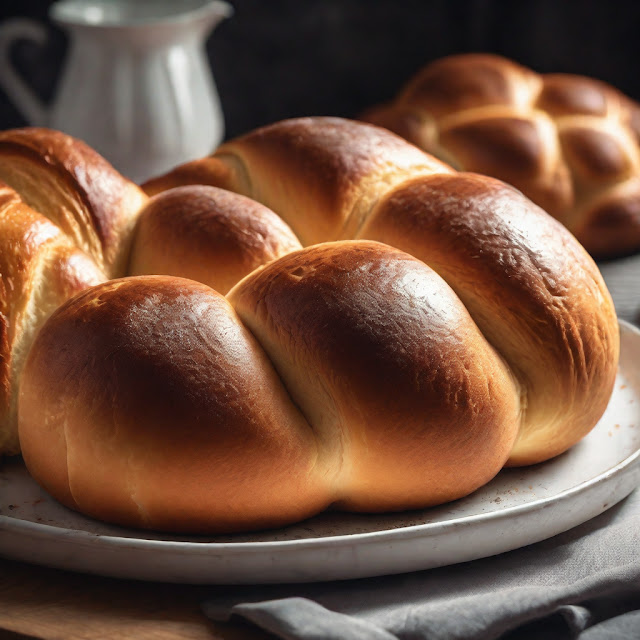In the heart of French patisseries, brioche emerges as a decadent protagonist—a golden tale of indulgence and tradition. Enveloped in layers of buttery luxury, this dough, with its origins rooted in Parisian mastery, weaves a rich narrative of taste and texture. With a tender crumb that whispers of meticulous craftsmanship, brioche transcends mere bread; it becomes an edible ode to morning rituals and festive gatherings. Whether in the iconic tête shape or braided allure, each slice tells a story of warmth, sophistication, and the timeless artistry of French baking—a story that unfolds in every delightful bite.
Features of Brioche:
1. Rich, Buttery Texture:
Brioche, a French pastry, is celebrated for its indulgent, buttery texture. The dough is enriched with eggs and butter, creating a tender and flaky crumb.
2. Versatile Applications:
This versatile dough is used in various forms, from traditional brioche loaves to buns, rolls, and sweet treats like brioche aux fruits or brioche à tête.
3. Sweet or Savory Options:
Brioche caters to diverse palates, with sweet variations featuring sugar, vanilla, or chocolate, and savory options incorporating herbs, cheese, or even cured meats.
4. Puffy and Light Consistency:
Brioche dough undergoes a meticulous process, involving multiple proofings, resulting in a puffy, light interior encased in a golden-brown crust.
5. Perfect for Breakfast or Dessert:
Whether toasted and slathered with jam for breakfast or transformed into a decadent bread pudding for dessert, brioche elevates any culinary experience.
6. Iconic Brioche Shapes:
Brioche à tête, with its distinctive topknot, is an iconic shape, while simpler versions are braided or formed into buns, showcasing the artistry in brioche baking.
Brioche Recipe:
Ingredients:
4 cups all-purpose flour
1/4 cup granulated sugar
1 tablespoon active dry yeast
1 teaspoon salt
4 large eggs
1/2 cup warm milk
1 cup unsalted butter, softened
Egg wash (1 egg beaten with a tablespoon of water)
Instructions:
1. Activate the Yeast: In a bowl, combine warm milk, a pinch of sugar, and yeast. Allow it to sit for 5-10 minutes until foamy.
2. Prepare the Dough: In a large bowl, mix flour, sugar, and salt. Make a well in the center and add eggs and activated yeast mixture. Gradually incorporate the flour.
3. Incorporate Butter: Add softened butter gradually, kneading until the dough is smooth and elastic. This process may take about 15-20 minutes.
4. First Proofing: Place the dough in a greased bowl, cover, and let it rise in a warm place for 1-2 hours or until doubled in size.
5. Shape the Brioche: Punch down the dough and shape it into desired forms—a loaf, buns, or the classic brioche à tête. Place in greased pans or on a baking sheet.
6. Second Proofing: Allow the shaped dough to rise for an additional 1-2 hours until puffy.
7. Bake to Perfection: Preheat the oven to 375°F (190°C). Brush the brioche with egg wash and bake for 20-25 minutes or until golden brown.
8. Cool and Enjoy: Let the brioche cool before slicing. Indulge in the rich, buttery goodness of your homemade French brioche.
Note: Experiment with different shapes and flavor additions to create your signature brioche. From breakfast toast to delightful desserts, this classic brioche will become a staple in your kitchen.
Common Questions about Brioche:
What makes brioche different from regular bread?
A: Brioche stands out due to its high butter and egg content, resulting in a rich, tender crumb. This gives it a distinct, luxurious taste and texture compared to regular bread.
Q: Can I make brioche without a stand mixer?
A: Absolutely. While a stand mixer makes the process easier, brioche can be kneaded by hand. It requires more effort, but the results are equally rewarding.
Q: How do I store leftover brioche?
A: To maintain freshness, store leftover brioche in an airtight container at room temperature for up to two days. For longer storage, freeze and reheat when needed.
Q: What is the secret to a light and fluffy brioche?
A: The key is in proper proofing. Allow the dough to rise sufficiently during both the first and second proofing stages. This contributes to the light and airy texture of the finished brioche.
Q: Can I make brioche with whole wheat flour?
A: While traditional brioche uses all-purpose flour, you can experiment by replacing part of it with whole wheat flour. Keep in mind that this may alter the texture slightly.
Q: How do I achieve the perfect brioche shape?
A: Shaping brioche depends on the desired result. For the classic tête shape, divide the dough into portions, rolling one portion into a larger ball and placing a smaller ball on top. Experiment with braiding or forming buns for variety.

Comments
Post a Comment